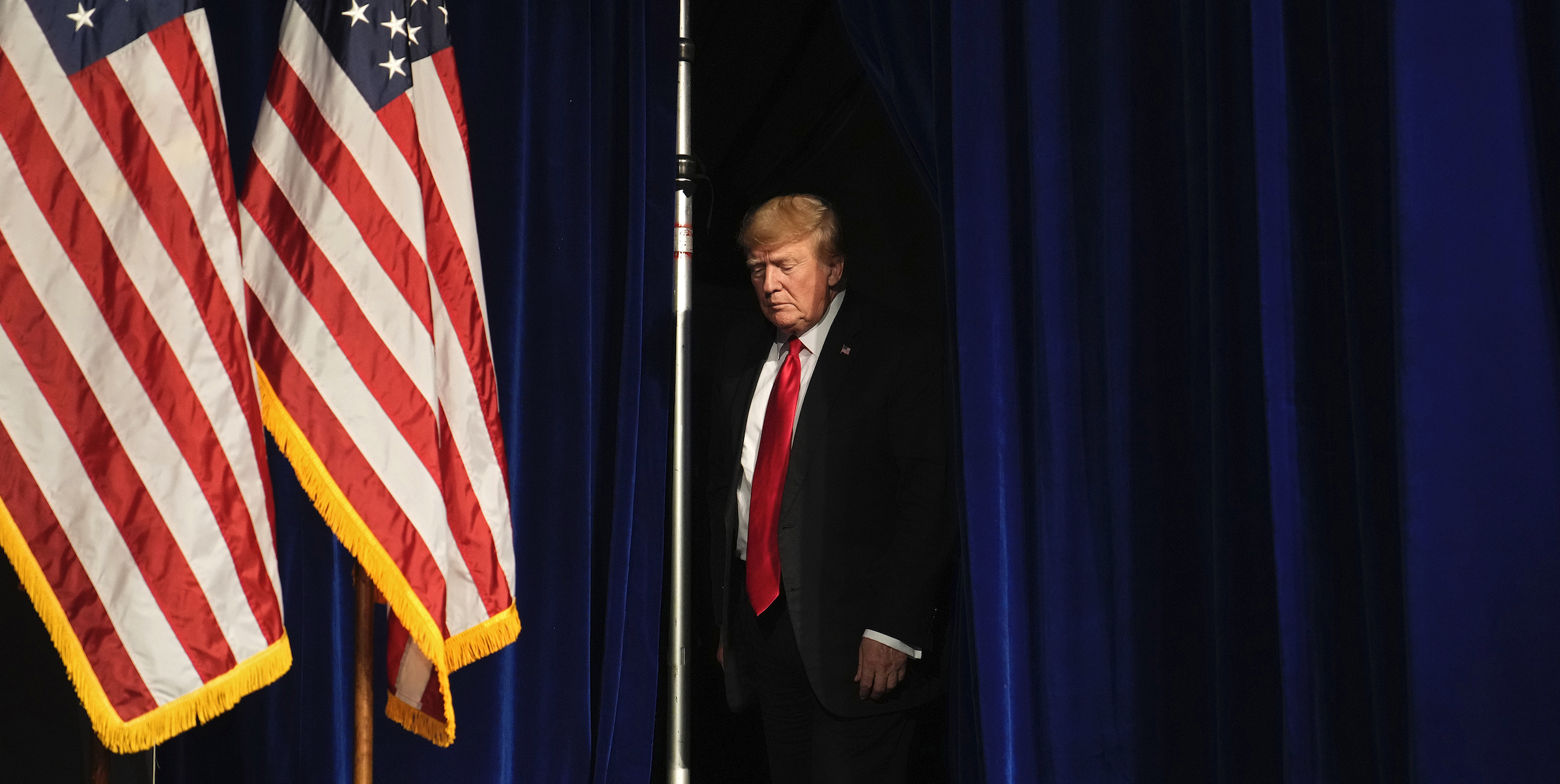Sign up for the daily CJR newsletter.
On Thursday, Axios published a story assessing Donald Trump’s potential cabinet appointments should he win reelection to the White House. Among those named in the story were Steve Bannon, who said on his podcast last week that a second Trump administration would prosecute so-called “deep-staters”; Kash Patel, who told Bannon in the same discussion that “we’re going to come after the people in the media who lied about American citizens, who helped Joe Biden rig presidential elections”; and Senator J.D. Vance, who, also last week, called on the Justice Department to investigate the author of a Washington Post op-ed warning that a “Trump dictatorship is increasingly inevitable.” On Friday, Susie Wiles and Chris LaCivita, top staffers with the Trump campaign, pushed back on the Axios story, telling the press that “unless a message is coming directly from President Trump or an authorized member of his campaign team, no aspect of future presidential staffing or policy announcements should be deemed official.” The “unusual statement,” the Post noted, came amid “an escalating response” to stories about Trump’s planned second-term authoritarianism that his campaign views as “unhelpful.” On Saturday, Trump himself dismissed what he is now calling “the ‘threat to democracy’ hoax.”
As this response attests, such stories have become increasingly common in the mainstream press in recent weeks—responding to the overt threats not only of Bannon, Patel, et al. but also of Trump, whose recent (and, for that matter, not so recent) rhetoric has not been that of a man determined to draw a bright line between the musings of outriders and his “official” word. (Since the summer, he has proposed the execution of the outgoing chair of the Joint Chiefs of Staff and the extrajudicial killing of petty criminals, accused MSNBC of treason and threatened to make the network “pay,” and channeled Hitler and Mussolini in deriding his political opponents as “vermin.”) Beyond individual reports on these comments, we’ve seen increasingly detailed journalism on what the nuts and bolts of a second Trump administration might look like; the New York Times is publishing an ongoing series on the question, while last week, The Atlantic released a special issue in which twenty-four contributors weighed Trump’s likely impact in a range of policy areas and concluded that it would likely be “much worse” than his first term. “I would prefer journalists to speak plainly about what they’re seeing,” Jeffrey Goldberg, The Atlantic’s editor in chief, told the CNN media reporter Oliver Darcy. “And I believe that a second Trump term poses a threat to the existence of America as we know it.”
Goldberg is hardly a progressive-media rabble-rouser; nor is Marty Baron, the former editor of the Post, who told NPR last week that he “absolutely” believes that democracy is at stake in the 2024 election; nor is Peter Baker, the chief White House correspondent at the Times, who concluded recently that we have arrived at a “fundamental moment of decision in the American experiment.” And yet, as Darcy noted in his interview with Goldberg, it’s still relatively rare to hear prominent mainstream-media figures use this sort of language publicly, even if they privately believe it. (David Leonhardt, who writes the Times’ flagship daily newsletter, conceded last week that he felt “uncomfortable” about Goldberg’s “harsh” language, even as he essentially endorsed his conclusion.) It’s still not unusual to hear Trump and his allies’ blatant threats couched in language that is euphemistic, softened, or passive. Some hoax.
Back in January, as part of an article laying out the media dynamics CJR’s staff would be watching this year, I wrote that I would be interested to see how media outlets continued to center—or didn’t—threats to democracy; I’d observed some progress on this front in 2022, but also feared that last year’s midterms—which brought defeat for the most ardent Trumpian election deniers running to assume oversight of the country’s election infrastructure—could push the question down the media agenda even though the threat hadn’t dissipated. That fear has not been realized, not least due to Trump’s frightening rhetoric and multiple indictments, and work like that of the Times and The Atlantic has kept the threat visible. If anything, though, the threat is even more real than it was this time last year, and I’m not convinced that the broad sweep of political coverage has kept pace with that reality. Political media has certainly not undergone the cultural reset required to elevate the future of democracy over more trivial pursuits—to a world where that question is not the subject of special series and issues, but the baseline norm. I also wrote in January that the press serving democracy would require more than just highlighting the loudest threats to it. That subtler work, too, remains incomplete.
Even the clear-eyed coverage has not been beyond reproach: The Nation’s Joan Walsh and Chris Lehmann indicted recent reports for treating the threat of Trumpian authoritarianism as an inevitability, when it can in fact be stopped (“Preachments of authoritarian fatalism are infinitely more seductive than the painful exercise of learning from one’s mistakes,” Lehmann wrote); the media critic Dan Froomkin argued that political reporters don’t seem interested in finding out why such a vision appeals to so many Americans. And much national political coverage this year has not been clear-eyed in the first place: as I’ve tracked in this newsletter, too much of it has remained obsessed with the election horse race, continued to treat Trump as an entertainment draw (particularly in the breathless coverage of his indictments) or otherwise played into his hands (exhibit A: the CNN town hall packed with his cheering partisans), and, most fundamentally, treated him as both an election subverter and a normal candidate.
In recent weeks, I’ve observed more of the same unevenness. When Trump compared his opponents to vermin, some headlines in major outlets centered the fascist lineage of the term, but others euphemized it and the story as a whole was arguably underplayed; the same could be said of other Trump remarks that would have made the front pages a few years ago but now don’t—a function, perhaps, of what the political scientist Brian Klaas has called the “banality of crazy.” Meanwhile, a political-media narrative has coalesced that Nikki Haley, a rival for the Republican presidential nomination, is surging even though she remains miles behind Trump in the polls—a narrative, as Politico’s Jack Shafer noted, that smacks of media wishcasting for horse-race drama. Listening to TV news chatter following last week’s Republican debate—which Trump once again skipped—it sometimes felt as if we were in a normal election, without Trump’s shadow looming over it. In fact, the debate, like others before it, was a sideshow.
I wrote in January that saving democracy would require media scrutiny of the functioning of America’s political and media systems as a whole, beyond Trump. On its face, this year brought a great deal of that—a central story line was dysfunction in Congress, and much of the coverage I saw was laudably clear-eyed about Republican responsibility for it. Often, though, that same coverage treated the drama more as personalized palace intrigue than a fundamental structural problem. Within the media industry, the debate on Fox between Florida governor Ron DeSantis and California governor Gavin Newsom—while flawed in its execution—offered a template for debating competing political visions absent an immediate horse race (DeSantis is running for president; Newsom is not), only for much of the follow-up coverage to cast the event as a confusing aberration and shove it through the mangle of horse-race analysis anyway. For a 2021 CJR issue on reimagining political coverage, I profiled Mehdi Hasan, of Peacock and MSNBC, whose explicitly pro-democracy approach and tough interviews with politicians from both sides of the aisle themselves were a template for more vigorous political journalism, albeit one rooted in Hasan’s unapologetic progressive views rather than performed neutrality. Last month, his shows were canceled. (He’ll stay at MSNBC as a guest anchor and on-air pundit.)
I continue to believe that American political journalism needs a radical reset to better serve democracy: less focus on the horse race and entertainment; more focus on policy; more cutting interviews; deeper thinking. Bad coverage of Trump is, to my mind, a function of these sorts of broader pathologies, which will take years to fix, if they’re fixable at all. But taking at least a step toward more accurate coverage of Trump and the threat he poses should be easy—increasingly, it only requires reporting what he himself is pledging to do and has already done, and describing it directly and honestly, as Goldberg, Baron, and others have. The potential reasons for downplaying his rhetoric are myriad: boredom (it’s just Trump bloviating), a failure to take it seriously (…it’s just Trump bloviating), a fear that accurate reporting will read as hysterical and biased amid a political-media culture that prizes civility, a vision of politics so gamified that members of the elite press don’t believe Trump will come after them, even as he and his allies promise just that. At this point, all these reasons are indefensible.
Again, more accurate language and a clearer recognition of the threat won’t fix political media, but they are—still, nearly eight years into the Trump era—an essential prerequisite for better coverage that too many outlets and journalists don’t seem able to step beyond; not consistently, at any rate. Yesterday, on CNN, Al Gore referenced Trump’s recent remark that he would be a “dictator” on day one of his presidency and wondered “what it’ll take for people to believe him when he tells us who he is.” Reposting the clip on X (formerly Twitter), Hasan noted that acquaintances, including other journalists, have told him to relax about the prospect of a second Trump term, evincing, in Hasan’s view, a “complacency and sheer unwillingness to pay attention to what is being said and done.” His show on MSNBC will end next month.
Other notable stories:
- On Friday, the Israeli military responded to a Reuters investigation finding that cross-border Israeli tank fire killed the news agency’s journalist Issam Abdallah in southern Lebanon in October; Israeli officials said that the incident remained under review, but that Abdallah was killed in an “active combat zone” that was “dangerous” following a Hezbollah attack on the border. (Human Rights Watch has characterized the killing of Abdallah as apparently deliberate and thus a war crime.) Elsewhere, pro-Palestinian protesters in Ohio demonstrated outside the Toledo Blade and the TV station WTOL, chanting “How many journalists need to die, before you call it genocide?” And a regional leader in France rescinded an award given to the journalist Zineb El Rhazoui after she shared a post comparing Israel’s bombing of Gaza to the Holocaust.
- The Post’s Paul Farhi profiled John Kirby, a National Security Council spokesperson who has become a prominent public face of the Biden administration amid the twin conflicts in Ukraine and the Middle East. “His profile on those issues has eclipsed that of press secretary Karine Jean-Pierre, fueling speculation within the gossipy White House press corps that Kirby is in line to succeed her as Biden’s chief spokesperson,” Farhi reports, with one reporter calling Kirby “the de facto co-press secretary.” (White House officials denied any succession planning.) “NSC spokespeople have briefed the press corps before, of course, particularly during periods of international crisis. But there’s no precedent over the past 20 years or so for the outsize role that Kirby has assumed.”
- The Wall Street Journal’s Isabella Simonetti and Keach Hagey report that Tucker Carlson, who was ousted from Fox News earlier this year, will today launch a paid subscription streaming service called the “Tucker Carlson Network.” Since leaving Fox, Carlson has been broadcasting on X; per the Journal, he considered housing his new network on the platform, but X “wasn’t able to move quickly enough to build out the technology they needed to run a subscription service.” Carlson will reportedly continue to post free content on X, though some content will now be subscriber-only. Neil Patel, who cofounded the right-wing Daily Caller with Carlson, will be the new network’s CEO.
- Late last week, top policymakers in the European Union reached agreement on broad proposals to regulate the development of artificial intelligence—a framework the Times describes as “one of the world’s first comprehensive attempts to limit the use” of the technology, and to strike a balance between its positive potential uses and negative potential threats. Among other requirements, software that makes manipulated images will be subject to more rigorous disclosure standards. The framework has not yet been finally approved. My colleague Mathew Ingram wrote recently about AI regulation.
- And police in Russia added Masha Gessen, the Russian American journalist and New Yorker writer, to a wanted list. Officials previously opened a criminal investigation into an interview that Gessen conducted last year, which featured a discussion of Russian military atrocities in Ukraine. Per The Guardian, Gessen “is unlikely to be arrested, unless they travel to a country with an extradition treaty with Russia. But a Russian court could still hold a trial in absentia and hand out a prison sentence of up to 10 years.”
ICYMI: Joan Donovan speaks out about Meta and her ouster from Harvard
Has America ever needed a media defender more than now? Help us by joining CJR today.







